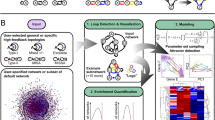Abstract
The modern systems biology approach to the study of molecular cellular biology, consists in the development of computational tools to support the formulation of new hypotheses on the molecular mechanisms underlying the observed cell behavior. Recent biotechnologies are able to provide precise measures of gene expression time courses in response to a large variety of internal and environmental perturbations. In this paper, we propose a simple algorithm for the selection of the “best” regulatory network motif among a number of alternatives, using the expression time course of the genes which are the final targets of the activated signalling pathway. To this aim, we considered the Hill nonlinear ODEs model to simulate the behavior of two ubiquitous motifs: the single input motif and the multi output feed-forward loop motif. Our algorithm has been tested on simulated noisy data assuming the presence of a step-wise regulatory signal. The results clearly show that our method is potentially able to robustly discriminate between alternative motifs, thus providing a useful in silico identification tool for the experimenter.
Similar content being viewed by others
References
Alon, U.: Network motifs: theory and experimental approaches. Nat. Rev., Genet. 8, 450–461 (2007)
Angeli, D., Sontag, E.D.: Oscillations in I/O monotone systems. IEEE Trans. Circuits Syst. Spec. Issue Syst. Bio. 55, 166–176 (2008)
Dalla Mora, M., Germani, A., Manes, C.: Design of state observers from a drift-observability property. IEEE Trans. Automat. Contr. 45(8), 1536–1540 (2000)
de Jong, H.: Modeling and simulation of genetic regulatory systems: a literature review. J. Comput. Biol. 9(1), 67–103 (2002)
Farina, L., De Santis, A., Morelli, G., Ruberti, I.: Dynamic measure of gene co-regulation. IET Syst. Biol. 1(1), 10–17 (2007)
Friedman, N., Linial, M., Nachman, I., Pe’er, D.: Using Bayesian networks to analyze expression data. J. Comp. Biol. 7, 601–620 (2000)
Gardner, T.S., Faith, J.J.: Reverse-engineering transcription control networks. Physics of Life Reviews 2, 65–88 (2005)
Garneau, N.L., Wilusz, J., Wilusz, C.J.: The highways and byways of mRNA decay. Nat. Rev. Mol. Cell. Bio. 8, 113–126 (2007)
Husmeier, D.: Sensitivity and specificity of inferring genetic regulatory interactions from microarray experiments with dynamic Bayesian networks. Bioinformatics 19(17), 2271–2282 (2003)
Kitano, H.: Computational systems biology. Nature 420, 206–210 (2002)
Kitano, H.: Towards a theory of biological robustness. Mol. Syst. Biol. 3, 137 (2007)
Krishna, S., Maslov, S., Sneppen, K.: UV-induced mutagenesis in escherichia coli SOS response: a quantitative model. PLoS Comput Biol 3(3), e41 (2007)
Lee et al.: Transcriptional regulatory networks in Saccharomyces cerevisiae. Science 298(25), 799–804 (2002)
Luscombe, N.M., Babu, M.M., Yu, H., Snyder, M., Teichmann, S.A., Gerstein, M.: Genomic analysis of regulatory network dynamics reveals large topological changes. Nature 431(16), 308–312 (2004)
Mangan, S., Zaslaver, A., Alon, U.: The coherent feedforward loop serves as a sign-sensitive delay element in transcription networks. J. Mol. Biol. 334(2), 197–204 (2003)
Mogno, I., Farina, L., Gardner, T.: CRP drives a non-specific expression burst in E. coli sugar catabolic operons during starvation (submitted)
Nelder, J.A., Mead, R.: A simplex method for function minimization. Comput. J. 7, 308–313 (1965)
Palumbo, M.C., Farina, L., De Santis, A., Giuliani, A., Colosimo, A., Morelli, G., Ruberti, I.: Collective behaviour in gene regulation: post-transcriptional regulation and the temporal compartmentalization of cellular cycles, FEBS J. 275, 2364–2371 (2008)
Perkins, T.J., Hallett, M., Glass, L.: Inferring models of gene expression dynamics. J. Theor. Biol. 230(3), 289–299 (2004)
Perkins, T.J., Jaeger, J., Reinitz, J., Glass, L.: Reverse engineering the gap gene network of drosophila melanogaster. PLoS Comput. Biol. 2(5), e51 (2006)
Ripp, S., Moser, S., Weathers, B., Caylor, S., Blalock, B., Islam, S., Sayler, G.: Bioluminescent bioreporter integrated circuit (BBIC) sensors. In: Bio Micro and Nanosystems Conference, BMN ’06, pp. 59-60. San Francisco, CA (2006)
Soranzo, N., Bianconi, G., Altafini, C.: Comparing association network algorithms for reverse engineering of large scale gene regulatory networks: synthetic vs real data. Bioinformatics 23(13), 1640–1647 (2007)
Stelling, J., Sauer, U., Szallasi, Z., Doyle III, F.J., Doyle, J.: Robustness of cellular functions. Cell 118, 675–685 (2004)
Yi, T.M., Huang, Y., Simon, M.I., Doyle, J.: Robust perfect adaptation in bacterial chemotaxis through integral feedback control. Proc. Natl. Acad. Sci. U.S.A. 97(9), 4649–4653 (2000)
Zaslaver, A., Bren, A., Ronen, M., Itzkovitz, S., Kikoin, I., Shavit, S., Liebermeister, W., Surette, M.G., Alon, U.: A comprehensive library of fluorescent transcriptional reporters for Escherichia coli. Nature Methods 3, 623–628 (2006)
Author information
Authors and Affiliations
Corresponding author
Additional information
This work is supported by CNR (Italian National Research Council).
Rights and permissions
About this article
Cite this article
Farina, L., Germani, A., Mavelli, G. et al. Identification of Regulatory Network Motifs from Gene Expression Data. J Math Model Algor 9, 233–245 (2010). https://doi.org/10.1007/s10852-010-9137-x
Received:
Accepted:
Published:
Issue Date:
DOI: https://doi.org/10.1007/s10852-010-9137-x




